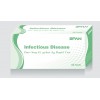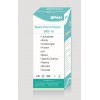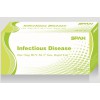INTENDED USE
The Typhoid IgG/IgM Rapid Test Device is a lateral flow immunoassay for the simultaneous detection and differentiation of anti-Salmonella typhi (S. typhi) IgG and IgM in human whole blood, serum or plasma.
SUMMARY AND EXPLANATION OF THE TEST
Typhoid fever is caused by S. typhi, a Gram-negative bacterium. World-wide an estimated 17 million cases and 600,000 associated deaths occur annually1. Patients who are infected with HIV are at significantly increased risk of clinical infection with S. typhi2. Evidence of H. pylori infection also presents an increase risk of acquiring typhoid fever. 1-5% of patients become chronic carrier harboring S. typhi in the gallbladder.
The clinical diagnosis of typhoid fever depends on the isolation of S. typhi from blood, bone marrow or a specific anatomic lesion. In the facilities that can not afford to perform this complicated and time-consuming procedure, Filix-Widal test is used to facilitate the diagnosis. However, many limitations lead to difficulties in the interpretation of the Widal test3,4.
In contrast, the Typhoid IgG/IgM Rapid Test Device is a simple and rapid laboratory test. The test simultaneously detects and differentiates the IgG and the IgM antibodies to S. typhi specific antigen5 thus to aid in the determination of current or previous exposure to the S. typhi.
TEST PRINCIPLE
The Typhoid IgG/IgM Rapid Test Device is a lateral flow chromatographic immunoassay. The test cassette consists of: 1) a burgundy colored conjugate pad containing recombinant S. typhoid H antigen and O antigen conjugated with colloid gold (Typhoid conjugates) and rabbit IgG-gold conjugates, 2) a nitrocellulose membrane strip containing two test bands (IgG and IgM bands) and a control band (C band). The IgM band is pre-coated with monoclonal anti-human IgM for the detection of IgM anti-S. typhi, IgG band is pre-coated with reagents for the detection of IgG anti-S. typhi , and the C band is pre-coated with goat anti rabbit IgG.
When an adequate volume of test specimen is dispensed into the sample well of the cassette, the test specimen migrates by capillary action across the test cassette. Anti-S. typhi IgM if present in the patient specimen will bind to the Typhoid conjugates. The immunocomplex is then captured on the membrane by the pre-coated anti-human IgM antibody, forming a burgundy colored IgM band, indicating a S. typhi IgM positive test result.
Anti-S. typhi IgG if present in the patient specimen will bind to the Typhoid conjugates. The immunocomplex is then captured by the pre-coated reagents on the membrane, forming a burgundy colored IgG band, indicating a S. typhi IgG positive test result.
Absence of any test bands suggests a negative result. The test contains an internal control (C band) which should exhibit a burgundy colored band of the immunocomplex of goat anti rabbit IgG/rabbit IgG-gold conjugate regardless of the color development on any of the test bands. Otherwise, the test result is invalid and the specimen must be retested with another device.
REAGENTS AND MATERIALS PROVIDED
1. 25 Test Device with 25 dropper
2.Sample Diluent
3.One package insert (instruction for use)
.
MATERIALS REQUIRED BUT NOT PROVIDED
Clock or Timer
WARNINGS AND PRECAUTUIONS
1.Do not use after expiration date indicated on the package. Do not use the test if its foil pouch is damaged. Do not reuse tests.
2.The products should be treated as potentially infectious, and handled observing the usual safety precautions (do not ingest or inhale).
3.Avoid cross-contamination of specimens by using a new specimen collection container for each specimen obtained.
4.Do not eat, drink or smoke in the area where the specimens and kits are handled. Handle all specimens as if they contain infectious agents. Observe established precautions against microbiological hazards throughout the procedure and follow the standard procedures for proper disposal of specimens. Wear protective clothing such as laboratory coats, disposable gloves and eye protection when specimens are assayed.
5.Do not interchange or mix reagents from different lots.
6.Humidity and temperature can adversely affect results.
7.The used testing materials should be discarded in accordance with local, state and/or federal regulations.
REAGENT PREPARATION AND STORAGE INSTRUCTIONS
All reagents are ready to use as supplied. Store unused test devices unopened at 2°C-30°C. The positive and negative controls should be kept at 2°C-8°C. If stored at 2°C-8°C, ensure that the test device is brought to room temperature before opening. The test device is stable through the expiration date printed on the sealed pouch. Do not freeze the kit or expose the kit over 30°C.
SPECIMEN COLLECTION AND HANDLING
Consider any materials of human origin as infectious and handle them using standard biosafety procedures.
Whole Blood specimens:
Collect blood specimen into a lavender, blue or green top collection tube (containing EDTA, citrate or heparin, respectively in Vacutainer®) by veinpuncture.
Plasma
Collect blood specimen into a lavender, blue or green top collection tube (containing EDTA, citrate or heparin, respectively in Vacutainer®) by veinpuncture. Separate the plasma by centrifugation. Carefully withdraw the plasma into new pre-labeled tube.
Serum
Collect blood specimen into a red top collection tube (containing no anticoagulants in Vacutainer®) by veinpuncture. Allow the blood to clot. Separate the serum by centrifugation. Carefully withdraw the serum into a new pre-labeled tube.
Test specimens as soon as possible after collecting. Store specimens at 2°C-8°C if not tested immediately.
Store specimens at 2°C-8°C up to 5 days. The specimens should be frozen at -20°C for longer storage.
Avoid multiple freeze-thaw cycles. Prior to testing, bring frozen specimens to room temperature slowly and mix gently. Specimens containing visible particulate matter should be clarified by centrifugation before testing. Do not use samples demonstrating gross lipemia, gross hemolysis or turbidity in order to avoid interference on result interpretation.
Bring specimens to room temperature prior to testing. Frozen specimens must be completely thawed and mixed well prior to testing. Specimens should not be frozen and thawed repeatedly.
If specimens are to be shipped, they should be packed in compliance with local regulations covering the transportation of etiologic agents.
ASSAY PROCEDURE
Allow test device, specimen, buffer and/or controls to reach room temperature (15‑30°C) prior to testing.
1. Bring the pouch to room temperature before opening it. Remove the test device from the sealed pouch and use it as soon as possible.
2. Place the test device on a clean and level surface.
For Whole Blood, Serum or Plasma specimens:
Hold the dropper vertically and transfer 2 drops of specimen (or approximately 50 µL) to the specimen well (S) of the test device, then add 1 drop of buffer and start the timer.
For Fingerstick Whole Blood specimens:
To use a capillary tube: Fill the capillary tube and transfer approximately 50 µL (or 2 drops) of fingerstick whole blood specimen to the specimen well (S) of the test device, then add 1 drop of buffer and start the timer.
3. Wait for the colored line(s) to appear. Read results at 10 minutes. Do not interpret results after 20 minutes.
INTERPRETATION OF ASSAY RESULT
POSITIVE RESULT:
IgG Positive:* The colored line in the control line region (C) appears and a colored line appears in test line region IgG. The result is positive for Dengue virus specific-IgG antibodies and is indicative of secondary Dengue infection.
IgM Positive:* The colored line in the control line region (C) appears and a colored line appears in test line region IgM. The result is positive for Dengue virus specific-IgM and is probably indicative of primary Dengue infection.
IgG and IgM Positive:* The colored line in the control line region (C) appears and two colored lines should appear in test line regions IgG and IgM. The color intensities of the lines do not have to match. The result is positive for IgG & IgM antibodies and is indicative of secondary Dengue infection.
NOTE: The intensity of the color in the test line region(s) will vary depending on the concentration of Dengue antibodies in the specimen. Therefore, any shade of color in the test line region(s) should be considered positive.
NEGATIVE RESULT:
The colored line in the control line region (C) appears. No line appears in test line regions IgG or IgM.
INVALID RESULT:
Control line (C) falls to appear. Insufficient buffer volume or incorrect procedural techniques are the most likely reasons for control line failure. Review the procedure and repeat the procedure with a new test device. If the problem persists, discontinue using the test kit immediately and contact your local distributor.













